Namibia |
|
|
|
| Übersicht – Contents: | |
Diese Seite ist Teil des Projektes
Namibia |
|
|
|
| Übersicht – Contents: | |
Flagge – Flag: |
|
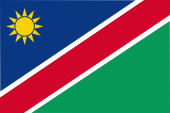 |
Nationalflagge |
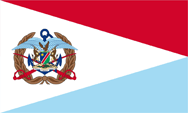 |
Flagge der Streitkräfte |
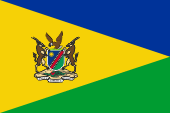 |
Flagge des Präsidenten |
historische Flaggen – historical Flags: |
|
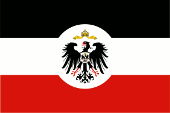 |
1893–1919, |
 |
1914, |
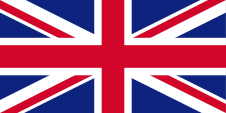 |
1915–1928, |
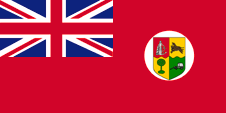 |
1919–1928, |
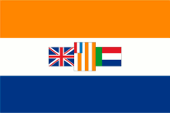 |
1928–1982, |
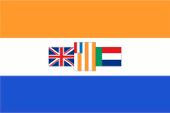 |
1982–1990, |
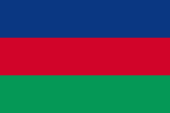 |
1966–1990, |
| Die heutige Flagge wurde am 21.03.1990 im Zusammenhang mit der Proklamation der Unabhängigkeit von Südafrika erstmals offiziell gehisst. Sie wird durch einen weiß gesäumten roten Streifen schräggeteilt. Links oben ein blaues Dreieck mit zwölfstrahliger gelber Sonne mit blauem Ring, rechts unten ein grünes Dreieck. Offiziell steht Blau für den Himmel, den Atlantik, Regen und Wasser, die gelbe Sonne für Lebenskraft. Rot steht für das Volk, Weiß für das friedliche Zusammenleben der verschiedenen Bevölkerungsgruppen, sowie für Einheit und Frieden. Grün ist das Sinnbild für Vegetation und Fruchtbarkeit. Die Flagge basiert eigentlich auf den Farben der Flagge der SWAPO (blau-rot-grün waagerecht gestreift), der politischen Bewegung die Namibia in die Unabhängigkeit geführt hat. Die schmalen weißen Zwischenstreifen und die goldene Sonne wurden nur hinzugefügt, damit auch die Farben anderer Parteien vertreten sind. Die zwölf Strahlen der Sonne könnten für die zwölf ethnischen Gruppen des Landes stehen. Die Farben der Flagge sind in der "Government Gazette" niedergelegt. Sie werden folgendermaßen angegeben: Blau = Pantone 294, Gelb = Pantone 116, Grün = Pantone 347, Rot = Pantone 186. Die Flagge des Präsidenten und die Flagge der Streitkräfte orientieren sich an der bis 1994 in Südafrika verwendeten Präsidentenflagge. | The
today's flag was hoisted for the first time on 21st of March in 1990 in
occasion of the proclamation of independence. It ist diagonally divided by a
white bordered red stripe. Left above a blue triangle with a twelve-pointed
yellow sun, right below a green triangle. Officially stands blue for the heaven, the Atlantic, rain and water, the yellow sun for live-power. Red stands for the nation, white for the peaceful cohabit of the various residental groups, as well as for unity and peace. Green is the symbol for vegetation and fruitfulness. The flag is actually based on the colours of the flag of the SWAPO (blue, red and green horizontally striped), that political movement which lead Namibia into the independence. The slender white stripes and the golden sun have been added only because to reperesent the colours of other parties. The twelve points of the sun could also represent the twelve ethnical groups of the country. The colours of the flag are laid down in the "Government Gazette". They are given as follows: Blue = Pantone 294, Yellow = Pantone 116, Green = Pantone 347, Red = Pantone 186. The presidential flag and the flag of the Armed Forces are based on the presidential flag used in South Africa until 1994. |
| Als deutsche Kolonie verwendete das Land keine besondere Nationalflagge. Es galten die Farben des Deutschen Reiches: Schwarz, Weiß und Rot. Behörden verwendeten die Flagge des Kolonialamtes sowie Abarten davon. Diese war zwar schwarz, weiß und rot waagerecht gestreift und zeigte in der Mitte eine weiße Scheibe mit dem Reichsadler. | As a German colony, the country did not use an own or special flag. There were used the colors of the German Empire: black, white and red. Authorities used the flag of the Colonial Office as well as varieties of it. That was black, white and red horizontally striped and showed in the middle of it a white disc with the imperial eagle. |
| Ab 1913 wurde überlegt, für die Kolonien eigene Hoheitszeichen zu schaffen. Erste Entwürfe lagen 1914 vor, jedoch wurde das Projekt wegen des Ausbruchs des Ersten Weltkriegs und wegen des Verlusts der Kolonien nicht mehr realisiert. |
From 1913 it was considered to create own emblems for the colonies. First drafts were made in 1914, but the project was not realized because of the outbreak of the First World War and because of the loss of the colonies. |
| Quelle/Source: Flaggen und Wappen der Welt, Die Welt der Flaggen, Wikipedia (D), Flags of the World | |
Wappen – Coat of Arms: |
|
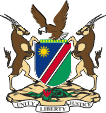 |
seit/since 1990, Wappen von Namibia – coat of arms of Namibia, Quelle/Source: Corel Draw 4 |
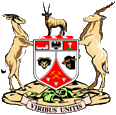 |
1963–1980, Wappen von Südwestafrika – coat of arms of South West Africa, Quelle/Source: Samhanin, CC BY 3.0, via Wikimedia Commons |
 |
1914, geplantes Wappen von Deutsch-Südwestafrika – planned coat of arms of German South West Africa, Quelle/Source: Flags of the World, Flag Reconstruction following Mark Sensen (Feb 98) based on traditional interpretation from Afrika-Nachrichten article 1933 |
| Das heutige Staatswappen wurde am 21.3.1990 eingeführt. Es zeigt das Design der Flagge im Schild. Schildhalter sind zwei Oryx-Antilopen. Oben auf dem Schild sind in einem grünen Wulst sechs stilisierte Diamanten zu sehen, darüber ein Fischadler. Unter dem Schild eine grüne Welvitschia-Mirabilis-Pflanze mit drei roten Blüten. Ganz unten ein weißes Spruchband mit dem Motto des Landes: "Unity, Liberty, Justice" → "Einheit, Freiheit, Gerechtigkeit" | The
today's coat of arms was introduced on 21st of March in 1990. It shows in
the shield the design of the flag. Shield-supporters are two Oryx-Antelopes.
Above the shield are to see six stylized diamonds in a green torus, there
above an fish-eagle. Below the shield a green Welvitschia-Mirabilis
plant with three red blossoms. Down below a white banner with the motto of
the state: |
| In der Zeit, als Namibia als Südwestafrika zu Südafrika gehörte wurde ein ähnliches Wappen verwendet. Es zeigte ein weißes Hauptschild mit einer von unten eingebogegen roten Spitze. Die rote Spitze war belegt mit Symbolen des Bergbaus: Hammer und Schlegel gekreuzt und in Gold sowie drei stilisierte Diamanten. Die Spitze wurde links und rechts begleitet von einem Widderkopf und einem Ochsenkopf. Das Schildhaupt war dreigeteilt. Das erste Feld war rot und zeigte die silberne Silhouette einer befestigten Siedlung, das zweite Feld war weiß mit dem Adler des Deutschen Reiches (die ehemalige Kolonialmacht) in der Mitte, und das dritte Feld war rot und zeigte ein Kruzifix auf einem grünen Hügel. Oberhalb des Schildes war ein rot-weißer Wulst mit einer Oryx-Antilope darauf. Schildhalter waren zwei Antilopen anderer Arten. Der Schildfuß war der gleiche wie im heutigen Wappen, jedoch blühte die Welvitschia-Pflanze nicht. Das Spruchband zeigte den lateinischen Spruch "Viribus Unitis" → "Mit vereinten Kräften". | In the times as Namibia belonged as South West Africa to South Africa was in use a similar coat of arms. It showed a white main-shield with a from below inwards bended red point. The red point was added by symbols of mining: hammer and pickhammer crossed and in gold as well as three stylized diamonds. The point was escorted to the left and to the right by an aries-head and an ox-head. The top of the shield was threefold partitioned. The first field was red and showed the silvery silhouette of a fortifyed housing estate, the second field was white with the Eagle of the German Empire (the former colonial might) in the middle, and the third field was red and showed a crucifix upon a green hill. Above the shield was a red-white torus with a Oryx antelope on it. Shield-supporters are two antelopes of other species. The shield pedestal was the same like in the today's coat of arms, but the Welvitschia plant was not flourishing. The banner showed the Latin motto "Viribus Unitis" → "With united Forces". |
| Das Land war einst eine deutsche Kolonie. Die deutschen Kolonien unterstanden – Kiautschou ausgenommen – dem Reichskolonialamt. Entsprechend verwendeten Behörden dessen Siegel, Flaggen und das Reichswappen. | The country was once a German colony. The German colonies – except Kiaochow – had been subordinated under the Imperial Colonial Office. Accordingly, public authorities used its seals, flags, and the Imperial coat of arms. |
| Ab 1913 wurde überlegt, für die Kolonien eigene Hoheitszeichen zu schaffen. Erste Entwürfe lagen 1914 vor, jedoch wurde das Projekt wegen des Ausbruchs des Ersten Weltkriegs und wegen des Verlusts der Kolonien nicht mehr realisiert. |
From 1913 it was considered to create own emblems for the colonies. First drafts were made in 1914, but the project was not realized because of the outbreak of the First World War and because of the loss of the colonies. |
| Das gedachte Aussehen der Wappen und Flaggen konnte in den 20er und 30er Jahren des 20. Jahrhunderts anhand von Fragmenten lediglich rekonstruiert werden. Die meisten Rekonstruktionen beziehen sich auf einen Artikel der Zeitung "Afrika-Nachrichten" von 1933 und die daraus folgenden Rekonstruktionen des niederländischen Vexillologen Mark Sensen vom Februar 1998, die auch auf diesen Seiten berücksichtigt werden. |
The imaginary appearance of the coats of arms and flags could only be reconstructed on the basis of fragments in the 20s and 30s of the 20th century.
Most of the reconstructions refer to an article in the newspaper "Afrika-Nachrichten" from 1933 and the subsequent reconstructions of the Dutch vexillologist Mark Sensen from February 1998, which are also taken into account on these pages. |
| Die Wappen selbst sollten oberhalb des Wappenschilds noch die Kaiserkrone tragen, jedoch nicht auf den Flaggen, wenn man der Rekonstruktion von Mark Sensen folgt. | The coats of arms themselves should additionally show the imperial crown above the escutcheon, but not on the flags, following the reconstruction of Mark Sensen. |
|
Die Wappenschilde zeigten immer den gleichen Aufbau: Ein horizontal zweigeteiltes Schild,
dessen Schildhaupt auf weiß den Reichsadler mit dem Brustschild des Hauses
Hohenzollern zeigte. Im Hauptteil eine stilisierte Darstellung von Pflanzen, Tieren oder Landschaften, die je nach Land unterschiedlich gefärbt waren. |
The escutcheons always showed the same structure: A horizontally twofold splited shield, the head of the shield showed the imperial eagle on white ground with the escutcheon of the House of Hohenzollern on the chest. In the main part appeared a stylized representation of plants, animals or landscapes, which were colored differently depending on the country. |
| Das geplante Wappen von Südwestafrika zeigte ein weißen Ochsenkopf unter einem Diamanten auf blauem Grund. | The planned coat of arms of South West Africa showed a white ox's head under a diamond on a blue background. |
| Quelle/Source: Flaggen und Wappen der Welt, Die Welt der Flaggen, Wikipedia (D), Flags of the World | |
Flugzeugkokarde – aircraft roundel: |
|
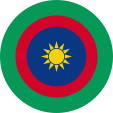 |
Flugzeugkokarde – aircraft roundel Quelle/Source, nach/by: Wikipedia (DE) |
Landkarte – Map: |
Lage – Position: |
Landkarte des Landes – Map of the Country: |
|
|
| Zahlen und Fakten – Numbers and Facts: | |
|
|
|
|
|
|
|
|
|
|
|
|
|
|
|
|
|
Mittelalter · Südwestafrika ist von Buschmännern (San), Ovambo und Damara
besiedelt 1485 · der portugiesische Seefahrer Diego Cão entdeckt und erkundet die Küste Südwestafrikas 17. Jhd. · einwandernde Namastämme, wie z.B. die Hottentotten (Khoi-Khoin) drängen die Urbevölkerung in die Wüsten ab 18. Jhd. · Hereros und Ovambo (Bantu-Völker) dringen in Südwestafrika ein und lassen sich nieder 19. Jhd. · von Süden her wandern europäisierte Khoi-Khoin-Stämme (Orlam) ein 1842 · die Deutsche Rheinische Missionsgesellschaft beginnt ihre Arbeit 1851 · die Orlam und Nama bezwingen die Herero 1863–1870 · erneuter Krieg der Orlam und Nama gegen die Herero 1878 · Großbritannien besetzt die Walfischbucht und unterstellt sie der Kapkolonie 1883 · die Firma F.A.E. Lüderitz lässt sich in der Angra-Pequena-Bucht (heute Lüderitzbucht) in der Siedlung Lüderitz nieder 1884 · Gründung der Stadt Bethanien 24.04.1884 · das Deutsche Reich unterstellt die Besitzungen der Firma F.A.E. Lüderitz (Küstengebiet von Südwestafrika) seinem Schutz 1885 · Gründung der Deutschen Kolonialgesellschaft für Südwestafrika, Ausdehnung des deutschen Kolonialbesitzes bis auf 240.000 km², erste Einwanderung von deutschen Siedlern, Grenzvertrag mit Großbritannien über den Verlauf der Grenze im Süden und Osten 1886 · Grenzvertrag mit Portugal über den Verlauf der Grenze im Norden (Angola) 1890 · Grenzvertrag mit Großbritannien über den Verlauf der Grenze im Nordosten (Caprivi-Zipfel) 1894 · der letzte Widerstand der Nama unter Hendrik Witbooi wird gebrochen 1904 · Herero-Aufstand im mittleren Norden, kurzfristig niedergeschlagen 1904 · Nama-Aufstand unter Hendrik Witbooi im mittleren Süden, erst 1907 niedergeschlagen, weitere Einwanderung von deutschen Siedlern 1908 · Entdeckung der Diamantenfelder in der Wüste Namib 1914–1918 · Erster Weltkrieg (1915/16 · Besetzung Südwestafrikas durch britisch-südafrikanische Truppen) 1920 · Versailler Diktat, das Deutsche Reich verliert alle seine Kolonien, Südwestafrika wird ein Mandatsgebiet des Völkerbundes unter Mandat der Südafrikanischen Union, die deutschen Siedler werden (im Gegensatz zu den anderen deutschen Kolonien) nicht vertrieben, Südafrika fördert die Besiedlung Südwestafrikas durch Buren 1945 · Südafrika erkennt die UNO als Nachfolgeorganisation des Völkerbundes nicht an, da für Südwestafrika als Endziel der Treuhand-Verwaltung (der UNO) die Unabhängigkeit des Landes vorgesehen ist 1946 · eine Volksabstimmung (unter den Europäern und Buren) beschließt den direkten Anschluss an die Südafrikanische Union 1948 · Einführung der Rassentrennung 1949 · Südwestafrika (einschl. der Walfischbucht) wird von der Südafrikanischen Union als seine fünfte Provinz annektiert 1959 · Gründung der SWANU-Partei (Südwestafrikanische Nationalunion), Rückhalt bei den Herero, Nama und Damara 1960 · Gründung der SWAPO-Partei (Südwestafrikanische Volksorganisation), Rückhalt bei den Ovambo 1964 · Schaffung von Reservaten für die Afrikaner 1966 · offizielle Aufhebung des südafrikanischen UNO-Mandats für Südwestafrika, die SWAPO beginnt den bewaffneten Kampf für die Unabhängigkeit 1967 · die UNO bestimmt einen Internationalen Verwaltungsrat für Südwestafrika 1968 · die UNO benennt Südwestafrika in Namibia um 1976 · Südafrika plant Namibia im Jahre 1978 in die Unabhängigkeit zu entlassen, das Projekt scheitert, da die UNO Truppen in der Region stationieren will 1977 · Südafrika setzt für Namibia einen Generaladministrator ein, das Land ist damit keine Provinz Südafrikas mehr, Südafrika annektiert die Walfischbucht 1978 · Wahlen ohne Teilnahme der SWAPO, von UNO nicht anerkannt 1985 · Bildung einer schwarz-afrikanischen Übergangsregierung für Namibia, jedoch ohne Beteiligung der SWAPO 1988 · Abkommen zwischen Südafrika, Angola und Kuba über freie Wahlen in Namibia und den Abzug der kubanischen Truppen aus Angola 1989 · Wahlen unter Teilnahme der SWAPO, die SWAPO gewinnt die Mehrheit im Parlament 21.03.1990 · Unabhängigkeit, Proklamation der Republik Namibia, neue Verfassung, Namibia wird Mitglied des Commonwealth of Nations und der UNO 1994 · Südafrika tritt die Walfischbucht an Namibia ab 1994 · erneuter Sieg der SWAPO bei Wahlen 1997 · Proteste der Buschmänner (San) zum Erhalt ihrer Landrechte werden gewaltsam niedergeschlagen 1999 · erneuter Sieg der SWAPO bei Wahlen 2005 · einige der europäischen Siedler müssen ihren Landbesitz unter Wert an Namibia verkaufen (de facto Enteignung) |
| Middle
Ages · South West Africa is populated by Bushmen (San), Ovambo and Damara 1485 · the Portugese seafarer Diego Cão discoveres and explores the coast of South West Africa 17th cent. · immigrating Nama tribes – like the Hottentotts (Khoi-Khoin) – push aside the pristine population into the deserts 18th cent. · Herero and Ovambo (Bantu nations) invade South West Africa and settle 19th cent. · from the south immigrate europeized Khoi-Khoin tribes (Orlam) 1842 · the German Rhenish Mission Society starts its work 1851 · the Orlam and Nama vanquish the Herero 1863–1870 · once more war of the Orlam and Nama against the Herero 1878 · United Kingdom occupies the Whalefish Bay and subordinates it to the Cape Colony 1883 · the company F.A.E. Luederitz establishes in the Angra Pequena Bay (today Luederitz Bay) in the housing estate Luederitz 1884 · foundation of the town Bethanien 24th of April 1884 · the German Empire subordinates the possessions of the company F.A.E. Luederitz (coastal area of South West Africa) unser its protection 1885 · foundation of the German Colonial Society for South West Africa, expansion of the German colonial possession to 92 700 sq.mi., first immigration of German settlers, border treaty with United Kingdom about the course of the border in the south and in the east 1886 · border treaty with Portugal about the course of the border in the north (Angola) 1890 · border treaty with United Kingdom about the course of the border in the north east (Caprivi Strook) 1894 · the last resistance of the Nama under Hendrik Witbooi is broken 1904 · Herero revolt in the central north, short-termly suppressed 1904 · Nama revolt under Hendrik Witbooi in the central south, suppressed not until 1907, further immigration of German settlers 1908 · discovery of the diamond fields in the Namib Desert 1914–1918 · First World War (1915/16 · occupation of South West Africa by British and South African troops) 1920 · Versailles Dictate, the German Empire loses all its colonies, South West Africa becomes a Mandate Territory of the League of Nations under South African mandate, the German settlers get not exiled (in difference to the other German colonies), South Africa supports the settlement of South West Africa by Boers 1945 · South Africa recognizes the UNO not as succeeding organization of the League of Nations, because for South West Africa is planned as final target of the trust administration (of the UNO) the independence of the country 1946 · a referendum (under the Europeans and Boers) decides for the directly annexion to the South African Union 1948 · introduction of the apartheid 1949 · South West Africa (incl. the Whalefish Bay) gets annexed by the South African Union as its fifth province 1959 · foundation of the SWANU-Party (South West African National Union), supported by the Herero, Nama and Damara 1960 · foundation of the SWAPO-Party (South West African People's Organization), supported by the Ovambo 1964 · establishment of homelands for the Africans 1966 · official abolition of the South African UNO Mandate for South West Africa, the SWAPO starts the armed struggle for independence 1967 · the UNO destines an international administration council for South West Africa 1968 · the UNO renames South West Africa in Namibia 1976 · South Africa plans to dismiss Namibia into the independence in the year 1978, this project fails because the UNO wants to deploy troops in the region 1977 · South Africa deploys for Namibia a General Administrator, the country is in this way no longer a province of South Africa, South Africa annexes the Whalefish Bay 1978 · elections without participation of the SWAPO, not recognized by the UNO 1985 · establishment of a Black-African transient government for Namibia, but without participation of the SWAPO 1988 · agreement between South Africa, Angola and Cuba for free elections in Namibia and the withdrawal of the Cuban troops from Angola 1989 · elections under participation of the SWAPO, the SWAPO wins the majority in the parliament 21st of March in 1990 · independence, proclamation of the Republic of Namibia, new constitution, Namibia becomes member of the Commonwealth of Nations and the UNO 1994 · South Africa cedes the Whalefish Bay back to Namibia 1994 · once more victory of the SWAPO in elections 1997 · protest of the Bushmen (San) for the preservation of their property rights become suppressed by force 1999 · once more victory of the SWAPO in elections 2005 · some of the European settlers have to sell their land under prize to Namibia (de facto expropriation) |
| Quelle/Source: Atlas zur Geschichte, World Statesmen, Discovery '97, www.merkur.de |
| Eigentlich heißt das Land Südwestafrika, jedoch beschloss die UNO im Jahre 1968 dieses Land in Namibia umzubenennen. Das Wort "Namibia" hat seine Wurzeln im Namen der Wüste "Namib", die sich in 50 bis 100 km Breite fast die gesamte Antlantikküste Südwestafrikas entlangzieht. Der Name der Wüste "Namib" geht wiederum auf die Nama-Stämme (Hottentotten) zurück, die im 17. Jahrhundert hier einwanderten. | The real name of the country is South West Africa, but the UNO decided in the year 1968 to rename the land in Namibia. The word "Namibia" has its roots in the name of the "Namib" Desert which expands in a width of 20 to 40 miles along nearly the whole coast of the Atlantic Ocean. The name of the "Namib" Desert goes back to the Nama tribes (Hottentotts) which immigrate in here the 17th century. |
|
Quelle/Source: Handbuch der geographischen Namen, Volker Preuß |
|